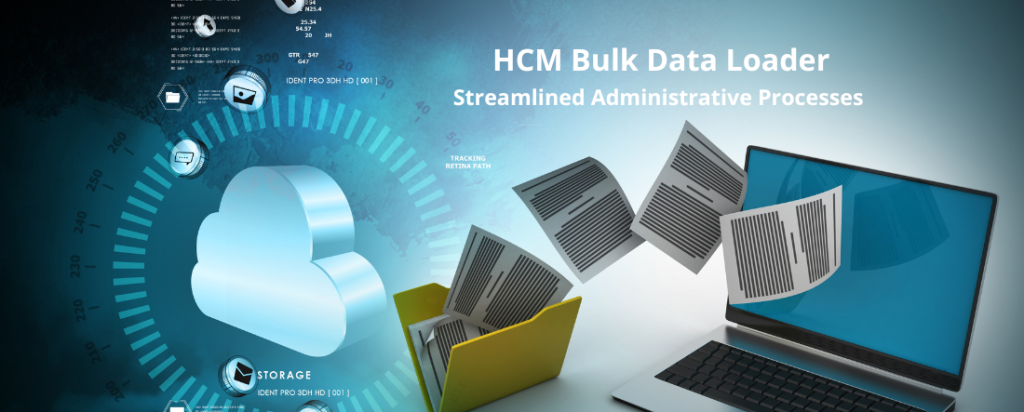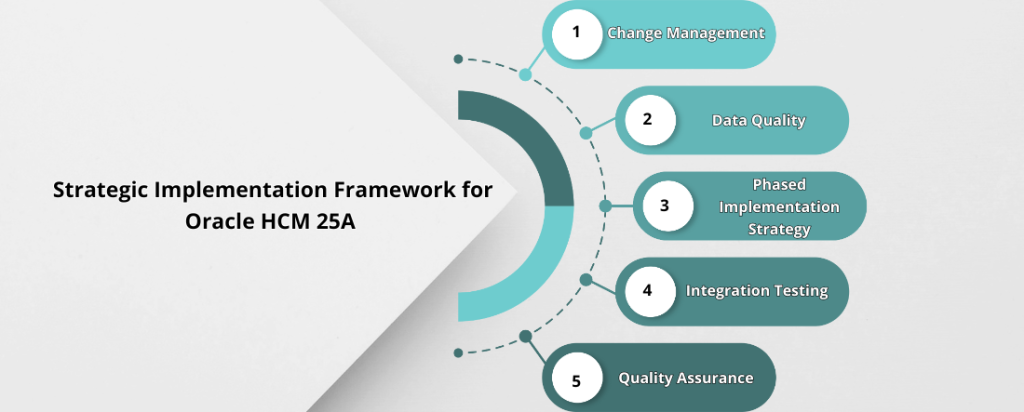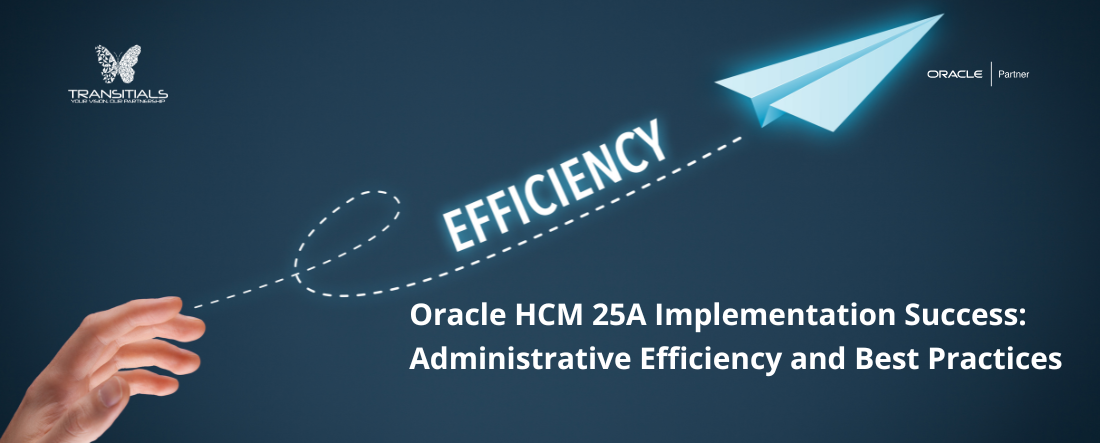Oracle HCM 25A Implementation Success
Administrative Efficiency and Best Practices
Introduction
Successful enterprise software implementation extends far beyond feature deployment—it requires strategic planning, administrative efficiency, and comprehensive change management. Oracle HCM 25A’s February 2025 release includes powerful administrative tools and capabilities that, when properly implemented, can transform organizational agility and data management effectiveness.
While the AI capabilities and user experience improvements in Oracle HCM 25A capture attention, the administrative enhancements provide the foundation for sustainable, scalable HR operations. The HCM Bulk Data Loader for Responsibility Templates represents a significant advancement in administrative efficiency, enabling organizations to manage complex organizational structures with unprecedented speed and accuracy.
This comprehensive guide explores both the technical capabilities of Oracle HCM 25A’s administrative tools and the strategic implementation approaches that ensure successful deployment. Organizations that master these administrative aspects position themselves to maximize the value of their Oracle HCM investment while maintaining operational excellence during periods of growth and change.

HCM Bulk Data Loader: Streamlined Administrative Excellence
Administrative efficiency often determines the practical success of HR technology implementations. The HCM Bulk Data Loader for Responsibility Templates in Oracle HCM 25A addresses one of the most time-consuming administrative challenges: managing complex responsibility structures across large organizations.
Mass Update Capabilities Transform Administrative Workflows
Traditional responsibility template management requires individual configuration of each template, including criteria definition, scope establishment, and staff assignment. This manual approach becomes unsustainable as organizations grow or undergo structural changes, leading to data inconsistencies and administrative bottlenecks.
The Bulk Data Loader enables HR administrators to create, modify, and delete entire responsibility template configurations simultaneously. This mass update capability includes all template components—criteria definitions, scope parameters, and directly assigned staff members—processed together in efficient batch operations.
Organizations can now implement enterprise-wide responsibility changes in hours rather than weeks, enabling rapid response to organizational restructuring, policy updates, or compliance requirements. This capability particularly benefits multinational organizations managing complex reporting structures across different jurisdictions and business units.
Error Reduction Through Systematic Processing
Manual data entry inevitably introduces human errors that can compromise system integrity and create compliance risks. The systematic data update procedures in the Bulk Data Loader eliminate most human-caused entry mistakes through automated validation and consistent processing logic.
The system verifies data integrity before processing updates, identifying potential conflicts or errors before they affect live operations. This proactive error detection prevents the cascading problems that often result from individual template mistakes, maintaining system reliability while reducing administrative oversight requirements.
Batch processing also ensures consistency across related templates, eliminating the variations that can occur when multiple administrators make individual updates using different approaches or interpretations.
Organizational Agility and Scalability
The Bulk Data Loader provides crucial organizational agility benefits that extend beyond immediate administrative efficiency. Organizations can implement complex structural changes quickly and accurately, responding to market conditions, growth opportunities, or strategic pivots without extensive system reconfiguration delays.
This agility becomes particularly valuable during mergers and acquisitions, where responsibility structures must be aligned rapidly to ensure operational continuity. The ability to process mass updates efficiently enables HR teams to focus on change management and employee communication rather than technical configuration tasks.
Template management efficiency also scales with organizational growth, allowing companies to maintain data consistency and operational effectiveness as they expand across new markets, locations, or business lines.

Strategic Implementation Framework for Oracle HCM 25A
Successful Oracle HCM 25A implementation requires comprehensive planning that addresses technical, organizational, and user adoption challenges. The following framework provides proven approaches for maximizing implementation success while minimizing operational disruption.
Change Management: Foundation for User Adoption
Technology implementations fail most often due to inadequate change management rather than technical issues. Oracle HCM 25A’s AI features and interface changes require particular attention to user preparation and ongoing support.
Comprehensive change management plans should begin with stakeholder analysis, identifying user groups affected by each new feature and their specific concerns or requirements. AI-powered features often generate anxiety about job security or system reliability, requiring clear communication about benefits and intended use cases.
Training programs must address both technical functionality and practical application, helping users understand not just how to use new features but when and why to use them effectively. This approach builds confidence and encourages adoption while reducing support requirements after implementation.
Data Quality: Essential Foundation for AI Success
AI-powered features in Oracle HCM 25A rely heavily on data quality to deliver accurate, useful results. Organizations should conduct comprehensive data audits before implementation, identifying and addressing inconsistencies, duplications, or missing information that could compromise AI performance.
Data cleaning efforts should focus particularly on the information sets that will feed AI journey creation and policy agent responses. Inconsistent job titles, incomplete position descriptions, or outdated policy documentation can significantly impact AI accuracy and user satisfaction.
Establishing ongoing data governance processes ensures continued AI effectiveness after implementation, maintaining the data quality standards necessary for optimal system performance.
Phased Implementation Strategy
Rather than implementing all Oracle HCM 25A features simultaneously, successful organizations typically adopt phased approaches that allow for learning, adjustment, and user adaptation between deployment stages.
Phase prioritization should consider organizational readiness, potential impact, and interdependencies between features. Many organizations begin with user experience improvements like Redwood enhancements, which provide immediate visible benefits while building confidence for subsequent AI feature deployments.
Each phase should include success metrics, user feedback collection, and adjustment periods that allow for optimization before proceeding to additional features. This approach reduces implementation risk while ensuring each feature delivers expected value before expanding scope.
Integration Testing and Quality Assurance
Oracle HCM 25A features must integrate seamlessly with existing customizations, third-party applications, and organizational workflows. Thorough testing protocols should verify functionality across all integration points, ensuring new features don’t disrupt existing operations.
Testing scenarios should include peak usage conditions, unusual data combinations, and edge cases that might not occur during normal operations but could cause problems in specific circumstances. This comprehensive testing approach identifies potential issues before they affect end users or business operations.
Quality assurance processes should also verify that new features perform as expected across different user roles, devices, and network conditions, ensuring consistent experiences for all organizational stakeholders.
Maximizing Return on Investment
Oracle HCM 25A implementation success ultimately depends on achieving measurable business value that justifies the investment and effort required. Organizations should establish clear metrics and monitoring processes that track both operational improvements and strategic benefits.
Operational Metrics and Efficiency Gains
Administrative efficiency improvements from the Bulk Data Loader can be measured through time-to-completion metrics for responsibility template updates, error rates in organizational data, and resource allocation for administrative tasks. These metrics provide concrete evidence of implementation value while identifying opportunities for further optimization.
User experience improvements should be tracked through adoption rates, support ticket volumes, and user satisfaction surveys. Higher self-service utilization and reduced training requirements indicate successful interface enhancements and user acceptance.
Strategic Benefits and Long-term Value
AI feature success should be evaluated through metrics like time-to-productivity for new hires, policy inquiry resolution times, and HR resource allocation toward strategic versus administrative activities. These measurements demonstrate the strategic value of AI implementation beyond immediate operational improvements.
Recruitment improvements through Express Apply can be tracked via application completion rates, candidate pool quality metrics, and time-to-hire measurements. These indicators help organizations understand the competitive advantages gained through enhanced candidate experiences.
Implementation Timeline and Resource Planning
Successful Oracle HCM 25A implementation typically requires 3-6 months for comprehensive deployment, depending on organizational size, complexity, and customization requirements. Resource planning should account for technical configuration, testing, training, and change management activities.
Key implementation milestones should include data preparation completion, user training delivery, pilot testing periods, and full deployment phases. Each milestone should have clear success criteria and contingency plans for addressing potential challenges or delays.
Organizations should also plan for ongoing optimization periods following initial deployment, allowing time to refine configurations based on user feedback and operational experience. This continuous improvement approach ensures maximum value realization from Oracle HCM 25A investments.
Conclusion
Oracle HCM 25A’s administrative capabilities and comprehensive feature set provide organizations with powerful tools for transforming HR operations and workforce management effectiveness. However, realizing these benefits requires strategic implementation approaches that address technical, organizational, and user adoption challenges systematically.
The HCM Bulk Data Loader exemplifies Oracle’s commitment to administrative efficiency, enabling organizations to manage complex responsibility structures with unprecedented speed and accuracy. When combined with proper implementation planning and change management, these capabilities position organizations for sustainable competitive advantages in talent management and operational excellence.
Organizations that invest in comprehensive implementation strategies, focusing on data quality, user adoption, and systematic testing, maximize their return on Oracle HCM 25A investments while building foundations for continued innovation and growth.
Ready to Implement Oracle HCM 25A Successfully?
Partner with experienced Oracle consultants to ensure your implementation delivers maximum value. Contact our implementation specialists to develop a customized deployment strategy that addresses your organization’s unique requirements and objectives.
Complete Your Oracle HCM 25A Knowledge:
Understand how generative AI and intelligent agents are transforming employee experiences and HR efficiency, providing the strategic context for implementation planning.
Explore the interface improvements and recruitment enhancements that will drive user adoption and candidate engagement in your implementation.
These three comprehensive guides provide complete coverage of Oracle HCM 25A’s transformative potential, from strategic vision through practical implementation. Together, they offer the insights needed to leverage this powerful platform for sustainable competitive advantage.

